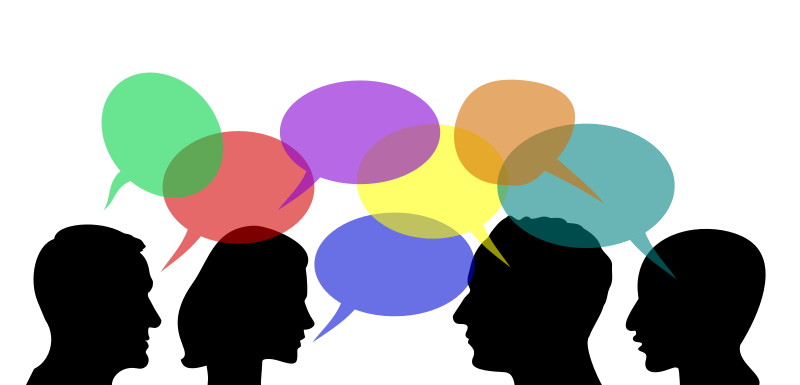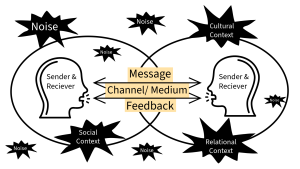This section is from this wiki https://en.wikibooks.org/wiki/Survey_of_Communication_Study/Chapter_1_-_Foundations:_Defining_Communication_and_Communication_Study
Introduction: Studying Communication Theory
In order to study and better understand communication theory, it’s important to define communication and explore this discipline in greater depth. Given the fact that we use communication every day in a variety of ways, many people think they have a keen understanding of this behavior. But communication is much more than speaking. Communication is a process where messages are encoded into a particular form, transmitted through a medium and received and decoded by the message recipient.
You are probably reading this book because you are taking an introductory Communication course at your college or university. Many colleges and universities around the country require students to take some type of communication course in order to graduate. Introductory Communication classes include courses on public speaking, interpersonal communication, or a class that combines both. While these are some of the most common introductory Communication courses, many Communication departments are now offering an introductory course that explains what Communication is, how it is studied as an academic field, and what areas of specialization make up the field of Communication. In other words, these are survey courses similar to courses such as Introduction to Sociology or Introduction to Psychology. Our goal in this text is to introduce you to the field of Communication as an academic discipline of study.
As professors, we hear a lot of people talk about communication both on and off our campuses. We’re often surprised at how few people can actually explain what communication is, or what Communication departments are about. Even our majors sometimes have a hard time explaining to others what it is they study in college. Throughout this book we will provide you with the basics for understanding what communication is, what Communication scholars and students study, and how you can effectively use the study of Communication in your life — whether or not you are a Communication major.
Defining Communication Study

When we tell others that we teach Communication, people often ask questions like, “Do you teach radio and television?” “Do you teach public speaking?” “Do you do news broadcasts?” “Do you work with computers?” “Do you study Public Relations?” “Is that Journalism or Mass Communication?” But, the most common question we get is, “What is that?” It’s interesting that most people will tell us they know what communication is, but they do not have a clear understanding of what it is Communication scholars study and teach in our academic discipline. In fact, many professors in other departments on our campus also ask us what it is we study and teach. If you’re a Communication major, you’ve probably been asked the same question, and like us, may have had a hard time answering it succinctly. If you memorize the definition below, you will have a quick and simple answer to those who ask you what you study as a Communication major.

CC0 1.0 UNIVERSAL
Bruce Smith, Harold Lasswell, and Ralph D. Casey provided a good and simple answer to the question, “What is Communication study?” They state that, communication study is an academic field whose primary focus is “who says what, through what channels (media) of communication, to whom, [and] what will be the results” (121).
Although they gave this explanation almost 70 years ago, to this day it succinctly describes the focus of Communication scholars and professionals. As professors and students of Communication, we extensively examine the various forms and outcomes of human communication.
On its website, the National Communication Association (NCA), our national organization, states that communication study “focuses on how people use messages to generate meanings within and across various contexts, cultures, channels and media. The discipline promotes the effective and ethical practice of human communication.” They go on to say, “Communication is a diverse discipline which includes inquiry by social scientists, humanists, and critical and cultural studies scholars.” Now, if people ask you what you’re studying in a Communication class, you have an answer!
We use Smith, Lasswell, and Casey’s definition to guide how we discuss the content in this book. Part I of this book sets the foundation by explaining the historical development of the Communication discipline, exploring the “what” and “channels” (verbal and nonverbal communication), and presenting the “whom” and “results” (theories and research methods). Before we get into those chapters, it is important for you to know how we define the actual term “communication” to give you context for our discussion of it throughout the book.
From this part until the end was put together with sourcing from the National Communication Association’s website:
What is Communication?
Here are some popular definitions of communication. They represent the breadth of perspectives that scholars have incorporated into defining this very complex concept.
Communication Definitions
The process of creating meaning through symbolic interaction – Adler, Rodman, duPre
The process by which people use symbols, signs and behaviors to exchange information – O’Hair & Weimann
Communication is the process through which the social fabric of relationships, groups, organizations, societies, and world order – and disorder – is created and maintained. – Brent Ruben
At its foundation, communication focuses on how people use messages to generate meanings within and across various contexts, and is the discipline that studies all forms, modes, media, and consequences of communication through humanistic, social scientific, and aesthetic inquiry. – NCA
The imparting or exchanging of information by speaking, writing, or using some other medium. The successful conveying or sharing of ideas and feelings. — Oxford English Dictionary
Communication is defined as the giving, receiving or exchanging of information, opinions or ideas so that the message is completely understood by everybody involved. — Unknown
Although it may seem straightforward, communication is complicated and the goal to get the message sent to equal the message received is challenging because human beings are complex and layered. Here are just a few of the many barriers to effective communication:
status and roles
cultural differences
choice of communication channel
length of communication
disabilities
use of language
individual perceptions
noise and distraction
clarity of message
feedback or lack thereof
With all of these factors to consider, it shouldn’t be surprising that it’s important to study communication.
Why is communication important?
At its foundation, Communication focuses on how people use messages to generate meanings within and across various contexts, and is the discipline that studies all forms, modes, media, and consequences of communication through humanistic, social scientific, and aesthetic inquiry.
Communication helps you understand and develop competence in personal, professional and social situations

Transactional Model of Communication
Image created with visual AI.
NCA. What is Communication?. National Communication Association, 2014. Web. June, 5, 2025.
Smith, Bruce Lannes, Harold Dwight Lasswell, and Ralph Droz Casey. Propaganda, Communication, and Public Opinion: A Comprehensive Reference Guide. Princeton University press, 1946. Print.


